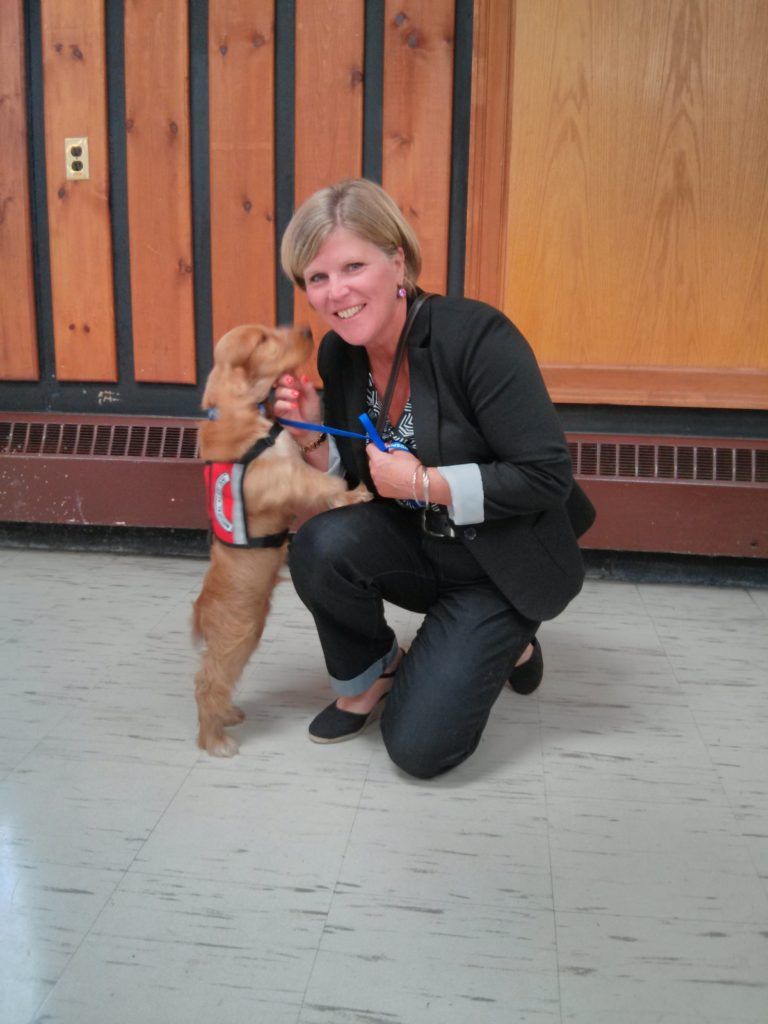Life Saving Diabetic Alert Dogs
A Diabetic Alert Dog can recognize the chemical changes in a person with type one diabetes and alert to the impending danger.
If you have questions that need answers about diabetic alert dogs check out this blog.
- A little information on diabetes.
- The first glucometer.
- Dog selection for the perfect life saving Diabetic Alert Dog.
- Training a life saving diabetic alert dog.
- Things to think about if you are considering a Diabetic Alert Dog.
- Family Commitment
- Belief in Training Protocols
- Financial Commitment
- Exercise and Social Commitment
- Training Maintenance
- Diabetic Alert Dog Organization Commitment
- Compliance Commitment
1. A Little Information on Diabetes
Type One Diabetes
Today, 11 million Canadians are living with diabetes or pre-diabetes. By 2027 that number will increase to 14 million. Diabetes is considered an epidemic.
2. The First Glucometer
Type One Diabetes
The first glucometer was invented in 1971 by Anton Huber Clemens. The glucometer is used to measure levels of glucose in the blood. This first glucometer was able to give an approximate reading. The early machine was only available in doctor’s offices and hospitals.
With the advancement of technology glucometers are now small, easy to use, and give accurate readings. A person who has no symptoms of dropping blood sugars can use their glucometers up to every 15 minutes out of fear of what is happening in their bodies. Complications from fluctuating glucose levels are devastating. Blindness, neuropathy, kidney disease, reduced defenses to fight infection to name only a few.
The work of JDRF (Juvenile Diabetes Research Foundation) External Link – http://www.JDRF.ca and the Canadian Diabetes Association External Link – http://www.diabetes.ca in partnerships with many companies, provide awareness, technology, education to manage diabetes and funding for research for a cure. Centers in hospitals that are dedicated to supporting children with diabetes, provide medical care that can make the difference. A long healthy life with few complications is a reality for people with type one diabetes..

3. Dog Selection for the Perfect Life Saving Diabetic Alert Dog
A diabetic alert dog is one more tool to support diabetes management, above all, for people who have no symptoms can be life saving.
As you can well imagine a dog selected to save the life of a child with brittle type one diabetes would need to be special.
The dog’s desire to please and the need to engage fully in the canine human relationship is essential. The need to always be in proximity of their human is a number one priority.
They must be calm, confident, social dogs. Going into public places with their human with diabetes requires the dog to be able to handle many different situations. Other dogs, busy malls, loud noises, smells of food and other appealing odors, dark theatres and small spaces. They need to be able to navigate these challenges with confidence and a calmness that protects the general public from an obtrusive, poorly managed dog.
Paradoxically these calm, confident dogs need to have a driven nature and this instinctual desire or impulse is naturally inherent in the dog. They need to have an instinct to use their noses to explore their environment. Next time you meet a new dog in a new situation watch how they learn about their surroundings. Do they visually take note of the environment or are they sniffing with their heads down taking in the newness with their noses? And does the dog follow you everywhere you go even into the bathroom and do they work hard to find a treat that is hidden as part of a game? A dog that will work tirelessly to find a treat hidden using their nose is a good candidate to be a Diabetic Alert Dog.
4. Training a Life Saving Diabetic Alert Dog
It is wonderful to watch a life saving diabetic alert dog alert to a low blood sugar.
You can tell the dog is smelling the changes in the person’s body chemistry as they begin to become restless and they begin to perform a ritual of sniffing and once they have established that they are smelling the target odor, they will begin the alerting process.
The alert begins with a nudge on the hand and will escalate to licking, pawing and climbing up on the person, doing whatever is necessary to get the response they are looking for in their person. The human response is checking their blood sugars using a glucose meter to validate the dog’s alert.
In other words, if the reading is 4.5 mmol/L (the standard unit of blood glucose measure in Canada) or below, the human will thank the dog, and the dog will continue to wait. It is imperative that low blood sugar be treated first and foremost for the safety of the person with type one diabetes.
The scent recognition is one of the easier tasks.
The more difficult piece is teaching the lifesaving diabetes alert dog in training to communicate with the alert and increase the intensity as it is needed. Positive reinforcement training relies on rewarding the behaviors you like and ignoring the behaviors you do not like. Through operant conditioning, a dog makes an association between a behavior and a consequence.
A life saving diabetic alert dog who performs an alert will always require deep sincere appreciation and a “puppy party!”

Diabetic Alert Dog in training and trainer Jodi Ferri with Tie Domi. He was hosting a book signing about his son with type one diabetes.

A dog is an emotional animal. The dog’s brain contains the amygdala. It is situated in the limbic system and it cries out for titillation. If you want your dog to “do it again” to remember “how sweet it is” you always add the emotional component.
A specially trained diabetic alert dog does NOT replace the glucometer. It does NOT replace the support of family for young children. It does NOT replace the care and expertise of the medical teams at the Diabetes Education Centers. A furry, loving companion is an extra safety net.
5. Things to think about if you are considering a diabetic alert dog
The success of a diabetes alert dog and child with type one diabetes team is not the sole responsibility of the dog or the trainer. There are many things to consider if you are thinking about getting a service dog for your child.
A success story!
6. Family Commitment
Firstly, the whole family needs to be fully onboard and committed to the diabetic alert dog. Secondly, there is rigorous training with the dog before it is placed in the home. Protocols of training must be followed up consistently at home by all members of the family for the dog to continue to work at capacity.
7. Belief in Training Protocols
The recipient of the service dog and the family needs to fully believe in the purpose behind the training protocols and the importance of maintaining these consistently. It is of the utmost importance that follow up and training maintenance be established. Trusting the trainers in the organization and the strategies that have been proven and are credible.
8. Financial Commitment
The cost to get a service dog really depends on the organization. Lions Foundation of Canada Dog Guides in Oakville, Ontario External Link – http://www.dogguides.com do not charge for their service. They are a registered charity that secure funding to cover their costs. Some charitable organizations will cover a large amount of the training costs and only charge a small fee. A private, for profit business can charge thousands of dollars. A thorough investigation of the business is crucial. Due diligence will pay off.
After the diabetic alert dog is fully trained, there are financial costs, for the lifetime of the dog. Such costs, as annual vet trips, update of immunizations, flea and tick medication, a comprehensive check up, budgeting at least $500.00 a year is prudent. Over and above health issues will cost much more. Licensing of a service dog in Ontario is no charge.
A new dog bed, crate, toys, fencing the yard for the safety of the dog, food, first vet visit can add up. According to Ontario Veterinary Medical Association External Link – http://www.ovma.org it can cost up to $3000 a year for the first few years of a puppy’s life. A service dog will not cost this much as the first years the costs were covered by the service dog organization. Budgeting for about half of this amount would be reasonable.
Quality food is also highly recommended for the service dog as the cost to train a diabetic alert dog can be upwards up $25,000. Budgeting to feed the dog the best maintains the health and wellness of the dog who can have a profound affect on the quality of the recipient’s life.
Grooming the diabetic alert dog professionally is crucial. Most importantly, they are out in public, and being clean and brushed is not only in the best interest of the public, moreover, the perception of the service dog industry. On average expect to pay between $30 and $90 for a standard grooming. Extras like nail clipping, flea treatments, teeth cleaning will cost more.
10. Training Maintenance
Depending on the organization where the service dog was trained there may be training maintenance opportunities for the life time of the dog. It is important to find out from the trainer what is included and to budget for these possible instances if it is not included.
11. Commitment of the Organization to the Service Dog
If the worst case scenario happens and for some reason the recipient cannot continue to maintain the quality of care for the diabetic alert dog, knowing what the organization offers in this event is important. A reputable organization does not want to see their dogs end up in shelters. They would maintain a policy that the dog be returned to them. These dogs are highly trained, and a great deal has been invested. As a result a diabetic alert dog maybe placed with another human to serve or continue to work in some capacity to help people.
12. Compliance Commitment
A reputable organization will have a lengthy, legal agreement between themselves and the recipient. The diabetic alert dog recipient needs to read carefully this agreement, as there will be steps outlined in the agreement for both the organization and the recipient. Compliance can be undervalued in the success of a service dog team. Both parties must adhere for the partnership to work. A lifesaving dog who alerts to low blood sugars is not magic. It take commitment, patience, training protocols and belief.
Life Saving Diabetic Alert Dog
The Value of a Life Saving Diabetic Alert Dog is Worth the Patience
Service dog organizations have different application policies. If you believe you are the right candidate to apply and be the recipient of a service dog to support your type one diabetes or your child’s reach out to them individually to find out what they require you to do. In conclusion, it can be a long process and there are wait lists, but the value of the diabetic alert dog for a person with brittle type one diabetes is worth the patience.

Life Saving Diabetic Alert Dog
Please share...


9. Exercise and Social Commitment
A service dog really does enjoy working. Dogs love to use their brains and they love to please their humans. Above this they need to be exercised and given the opportunity to just be dogs. Exercise allows them to burn off their energy, stay fit, strong and healthy and have fun. A general rule for exercise is between 30 minutes and 2 hours of exercise every day. This will depend on the size and breed of the dog. Walking the dog, running off leashed in a safe, secure environment or playing a game of ball can be choices.
Determining what is best for the dog will depend on what is most gratifying to them. Exercising or playing with your dog is a wonderful way to bond with them and it is also a real motivator for the human to get up and get out as well. If your disability is a challenge, make sure you have a family member or a friend who can be available to help you every day to ensure the appropriate amount of exercise and fun is maintained.